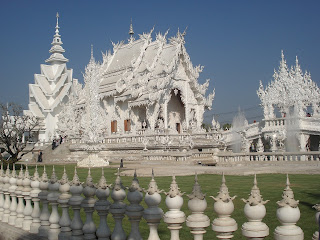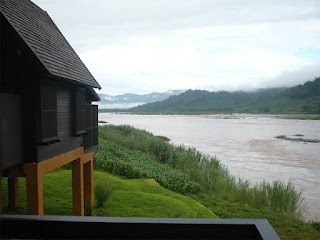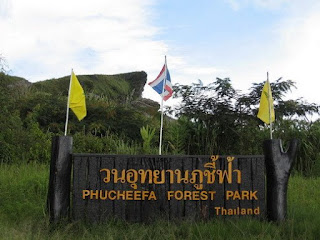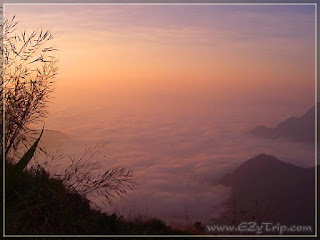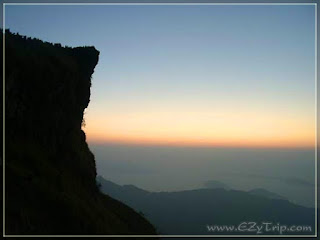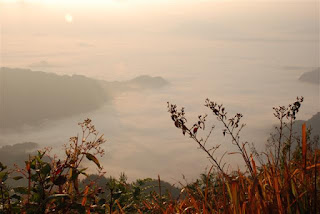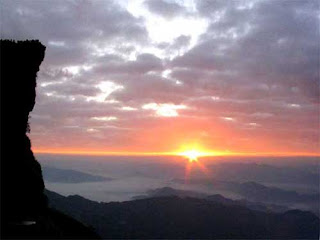
Chiang rai hotels resorts doi mae salong, Doi Tung, Phu Chi Fa Forest Park, Mae fa luang, Mae Sai, Chiang Saen, Chiang khong, Golden triangle, Doi Pa Tang, Namtok Khun Kon Forest Park, Mae Kok River, Namtok Khun Kon Forest Park, King Meng Rai the Great Monument
Wednesday, December 30, 2009
Sunday, December 20, 2009
Friday, December 4, 2009
Monday, September 7, 2009
Tuesday, June 9, 2009
Anantara Golden Triangle Resort and Spa

Anantara's Golden Triangle resort is a luxury nature retreat set amidst 160 acres of lush tropical jungles overlooking the winding Mekong River and the border with Burma and Laos.

Anantara Golden Triangle Resort & Spa - For views that rival the ones outside, look no further than the flat-screen TV that hangs in all 20 Burma View rooms - a modern amenity to accompany the traditional teak floors and Thai artworks surrounding it. In the bathroom, an oversized terrazzo bathtub provides an extra touch of luxury.

Anantara Golden Triangle Resort & Spa - Share a romantic bath for two in a deep terrazzo tub with a view of the Mekong. Silk, regional cottons, wooden accents and Thai artworks form the backdrop of your intimate hillside retreat.
Anantara Golden Triangle Resort & Spa
Saturday, January 3, 2009
Doi Mae Salong

Doi Mae Salong - The return trip can be taken on routes nos. 1234 and 1130 which wind through Yao and Akha hill tribe villages.

To reach Doi Mae Salong, take the Chiang Rai-Mae Chan route for 29 kilometers, then turn left and proceed for another 41 kilometers (passing a hot spring).

Doi Mae Salong - Scattered with many hill tribe villages, Doi Mae Salong is ideal for trekking.
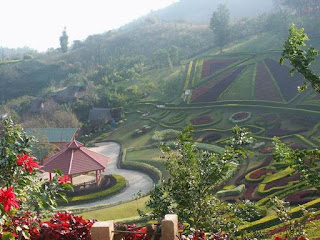
Doi Mae Salong - The scenery is especially picturesque in December and January when sakuras are in full bloom.

Doi Mae Salong - The village became well known for its enchanting scenery and tranquil atmosphere. Today it is a major tourist attraction with its small-town ambience, delicious native Chinese dishes, small hotels and guesthouses catering to visitors and tea, coffee and fruit tree plantations.

Doi Mae Salong is the site of Santi Khiri village, a community settled by the former Chinese 93rd Division who moved from Myanmar to reside on Thai territory in 1961. From Doi Mae Salong a road leads to Tha Thon, the starting point for the Kok River cruise, a distance of 45 kilometers. There are hotels and guesthouses to accommodate tourists and a paved road leading to the village.
Wat Phra That Doi Tung

Wat Phra That Doi Tung is situated on top of Doi Tung Mountain, the highest mountain in Chiang Rai Province with an elevation of approximately 2,000 meters, about 50 kilometers south of Mae Sai town which is near the Myanmar border. The temple can be reached via a 40-kilometer mountain road which meanders along the mountainside. The journey is worthwhile as the panoramic views into Laos and Myanmar at the peak are spectacular.
Mae Sai



Mae Sai which is about 62 kilometers from the provincial seat on Highway No. 110 is Thailand's northern-most district. Mae Sai borders on Myanmar's Tha Khi Lek marked by the Mae Sai River with a bridge spanning both sides. Foreign visitors are allowed to cross over to Tha Khi Lek market by presenting their passports and paying a fee at the Mae Sai immigration checkpoint. In addition, there are tour services to Chiang Tung in Myanmar, which is approximately 160 kilometers north by road.
Doi Tung

Doi Tung - The route winds through beautiful scenery with many interesting sites including the Doi Tung Palace (Pra Tamnak Doi tung), the Mae Fa Luang Garden and Akha and Muser tribal villages.

Doi Tung - IN addition to scenic lookouts, the most notable attraction is the Phra That Doi Tung Holy Relic, an old religious site atop the mountain.
Doi Tung - named in honor of the Princess Mother and the Doi Tung Development Project established by the late Princess Mother in 1987.
Doi Tung - The main attraction for visitors to Phra Tamnak Doi Tung is 'Suan Mae Fa Luang', the beautiful landscaped gardens filled with hundreds of different kinds of plants and flowers.
Doi Tung - Located on Doi Tung Mountain is a beautiful royal residence known as Phra Tamnak Doi Tung. The royal villa, situated on the slopes of the adjacent Pa Kluay Reservoir, was to serve as a royal winter retreat for the Princess Mother, who passed away in 1995 and was originally built on the theory that the local hill tribes would be honored by the royal presence and thereby cease their opium cultivation.
Wiang Kalong

Wiang Kalong, a newly-developed tourist attraction, is a community about 16 kilometers from the district office of Wiang Pa Pao. Ancient furnaces which were used to make terra cotta utensils called Kalong have been found in this area. The furnaces are shaped like turtle shells of various sizes with a width of 2 to 5 meters. To get there from the city, drive south along the Divided Highway No. 1 for 8 kilometers then take a right turn onto Highway No. 118 to Wiang Pa Pao (approximately 75-80 kilometers). For those wishing to travel from Chiang Rai to Chiang Mai via the Doi Saket Highway No. 1014, it is highly recommended to stop over at Wiang Kalong as it is on the way to Chiang Mai.
Phu Chee Fa Forest Park
Chiangrai

Chiang Rai, the northernmost province of Thailand is about 785 kilometers north of Bangkok. Situated on the Kok River basin, Chiang Rai covers an area of approximately 11,678 square meters with an average elevation of 580 meters above sea level. The province, which is located within the renowned Golden Triangle area where Myanmar, Laos and Thailand converge, is also known as the gateway to Myanmar, Laos and Southern China.Chiang Rai, which was founded in 1262 by King Meng Rai, was the first capital of the Lanna Thai Kingdom (Kingdom of a million rice fields), which was later conquered by Burma. It was not until 1786 that Chiang Rai became a Thai territory and was proclaimed a province during the reign of King Rama VI in 1910.Today, Chiang Rai is a traveler’s paradise endowed with abundant natural tourist attractions and antiquities; the province itself is evidence of past civilization. Attractions range from magnificent mountain scenery, ruins of ancient settlements, historic sites, Buddhist shrines and ethnic villages as the province is also home to several hill tribes who maintain fascinating lifestyles. For those interested in the natural side of Chiang Rai, jungle trekking is recommended along various trails.Chiang Rai which tends to be a little more 'laid back' now competes with Chiang Mai as a tourist attraction and is fast becoming a popular escape for tourists wanting to get away from the troubles they left behind.
Bangkok-Chiang Rai

Bangkok-Chiang Rai
By Air
There are a number of domestic airlines operating daily flights from Bangkok to Chiang Rai.
By Bus
The coach ride from Bangkok to Chiang Rai is probably best made overnight since passengers can avail themselves of sleep prior to an early morning arrival. There are both air-conditioned and non-air-conditioned bus services from Bangkok's Northern Bus Terminal (Mochit 2 Bus Terminal) on Kamphaengphet 2 Road. The journey may take approximately 9-11 hours.By CarTake Highway No. 1 (Phahonyothin Road), turn to route No. 32 passing Ayutthaya, Angthong and Singburi Provinces and change to route No. 11 passing Phitsanulok, Uttaradit and Phrae Provinces then turn left to Highway No. 103, drive through to Ngao District and turn right onto Highway No. 1 which takes you to Phayao and Chiang Rai Provinces. The total distance is 785 km.
By Rail
There is no direct train to Chiang Rai. You have to take a train to Lampang(9 hrs. from Bangkok) or Chiang Mai (11 hrs.) and then take a bus to Chiang Rai. (2 hrs. from Lampang and 1.30 hrs. from Chiang Mai) For more details, call the State Railway of Thailand, 1690 (hotline), or 0 2223 7010 or 0 2223 7020.
By Boat
The capital may also be reached from Tha Thon in Chiang Mai province by a scenic 4-6 hour (depending on climatic conditions, such as rain, and other factors such as high waters and fast currents) long-tail boat ride along the Mae Kok River.
By Air
There are a number of domestic airlines operating daily flights from Bangkok to Chiang Rai.
By Bus
The coach ride from Bangkok to Chiang Rai is probably best made overnight since passengers can avail themselves of sleep prior to an early morning arrival. There are both air-conditioned and non-air-conditioned bus services from Bangkok's Northern Bus Terminal (Mochit 2 Bus Terminal) on Kamphaengphet 2 Road. The journey may take approximately 9-11 hours.By CarTake Highway No. 1 (Phahonyothin Road), turn to route No. 32 passing Ayutthaya, Angthong and Singburi Provinces and change to route No. 11 passing Phitsanulok, Uttaradit and Phrae Provinces then turn left to Highway No. 103, drive through to Ngao District and turn right onto Highway No. 1 which takes you to Phayao and Chiang Rai Provinces. The total distance is 785 km.
By Rail
There is no direct train to Chiang Rai. You have to take a train to Lampang(9 hrs. from Bangkok) or Chiang Mai (11 hrs.) and then take a bus to Chiang Rai. (2 hrs. from Lampang and 1.30 hrs. from Chiang Mai) For more details, call the State Railway of Thailand, 1690 (hotline), or 0 2223 7010 or 0 2223 7020.
By Boat
The capital may also be reached from Tha Thon in Chiang Mai province by a scenic 4-6 hour (depending on climatic conditions, such as rain, and other factors such as high waters and fast currents) long-tail boat ride along the Mae Kok River.
Chiang Mai – Chiang Rai

By Bus - Chiang Rai is 182 kilometers north of Chiang Mai. Air conditioned buses leave 12 times daily from Chiang Mai Arcade Bus Terminal to Chiang Rai. Some buses continue to Mae Sai and Chiang Saen.
By Air - Airlines have numerous daily flights servicing the Bangkok-Chiang Mai route and the Chiang Mai-Chiang Rai route.
By Air - Airlines have numerous daily flights servicing the Bangkok-Chiang Mai route and the Chiang Mai-Chiang Rai route.
Festivals King Mengrai Festival

King Mengrai Festival This festival is held from January 26 - February 1 every year. The festival features parades, cultural performances and competitions celebrating the founder of Chiang Rai and the Lanna Thai Kingkom.
Lychee Fair
Lychee Fair This is held annually in May. Celebrating the province’s tastiest fruit, this fair features agricultural displays and exhibitions, local handicrafts, folk entertainment and beauty contests.
Songkran Festival
Songkran Festival Traditional Thai New year celebrations are best seen at Chiang Saen where 4 nations (Thailand, Laos, China and Myanmar) compete in boat races on the Mekong River. Beauty contests and cultural shows are added attractions. The festival is annually held from April 16-18.
Lychee Fair
Lychee Fair This is held annually in May. Celebrating the province’s tastiest fruit, this fair features agricultural displays and exhibitions, local handicrafts, folk entertainment and beauty contests.
Songkran Festival
Songkran Festival Traditional Thai New year celebrations are best seen at Chiang Saen where 4 nations (Thailand, Laos, China and Myanmar) compete in boat races on the Mekong River. Beauty contests and cultural shows are added attractions. The festival is annually held from April 16-18.
Subscribe to:
Comments (Atom)
